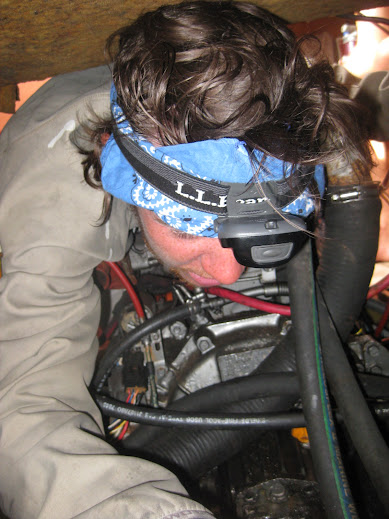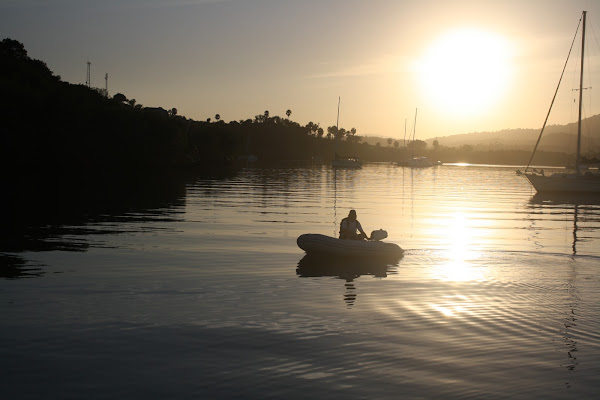 |
| (Mark communes with nature) |
|
The Dominican Republic boasts several impressive mountain ranges, filled with beautiful mountain rivers and the canyons, waterfalls, and white water rapids they create. A little asking around in Luperon made it clear that the place to head to and stage from on our excursion away from the sea was the mountain city of Jarabacoa. It was located up in the largest of the island's mountain ranges and on the edge of the huge Jose Del Carmen Ramirez National Park.
It took half a day of travel in the guaguas to work our way off the coast and up into the mountains to Jarabacoa. Guaguas were the bus system of the Dominican Republic and could get you anywhere and everywhere. The typical guagua was a beat up ten passenger Toyota van converted to take thirteen by the addition of extra seats that could be folded out from the end of each row to fill in the aisle. Bus
stations were typically just street corners, often without even a sign
to indicate it. Local knowledge was vital and we got a lot of practice
asking directions.
The guagua drivers were not paid an hourly wage but instead made their money directly from the passengers. As such, they were powerfully motivated to maximize usage. They didn't run on any sort of timetable we could figure out, waiting instead until they had enough passengers to make it worth the trip, usually about half capacity. Once underway, The guaguas stopped for every person who flagged them down along the route. At one point I counted twenty people in our guagua. No seat belt laws or max carrying capacity here. In fact, all the seat belts had been removed to save space and facilitate passenger movement.
 |
(Traveling in the GuaGuas)
|
Jarabacoa turned out to be a not very picturesque city in a very picturesque setting. We found a hotel room cheap enough to not come with blankets on the beds, enjoyed a fancy dinner out, and then headed back to turn in early.
The room had two double beds and there was some argument about who would sleep with who. Nate had assumed he would share one bed with Becca, and Mark and I would share the other. Mark and I had not assumed this. We all wanted Becca as a bed mate, she being the smallest and least stinky of the group. Nate eventually bought us off with a bottle of cheap wine.
The
next day we hired a local guide named Armando to take us around in his
truck to see the nearby waterfalls. He ran out of gas almost immediately after leaving town and while he
hiked back for more, we wandered off to explore. We met another local, a
former river rafting guide, who told us about the class IV rapids in
the area. We decided we'd do that the next day.
 |
(Learning from Armando)
|
Despite the shaky start, we were glad to have Armando as our guide, and not just because of the ready transportation. None of the waterfalls we visited were easily found. Poor signage, under-maintained and marked trails. We would not have found any of them on our own.
 |
(Hiking to one of the waterfalls)
|
 |
(Rock scrambling to the river)
|
The waterfalls were spectacular. Swimming, rock climbing, picnic on the beach, natural water slides. Aided by the use of some old climbing rope turned docklines we'd brought with us from the boat, I think we were able to get the full experience.
 |
(Natural water slide)
|
Nate and Mark led the charge out of the water to more dangerous activities. Having not satisfactorily risked immediate injury since the brittle coral cliffs of the Bahamas, they gaze up at the slippery, algea covered cliffs around the falls with eagerness. Soon simple bouldering at the water's edge wasn't enough and Nate strung the dock line from a rocky prominence over one of the mountain pools. Wet hands on wet rope provided too little friction to climb up and down so the rope was de-rigged and loops added every few feet. Nate and Mark climbed it. Becca opted out. Although I could climb up and down Strolla's mast like a monkey, this swinging, stretching, ladder of death was more than my appetite for risk would tolerate. After a half hearted attempt, I followed Becca's lead.
 |
(Nate's first attempt at a down climb without loops)
|
 |
(The rope with climbing loops added)
|
 |
(Peter considers a climb, and decides against it)
|
 |
(Swimming with waterfalls)
|
 |
(enjoying our perch)
|
As
planned, the next day we went white water rafting. It was a half day
trip that included breakfast and lunch. The river was small but the rapids stretch took us though a stunningly beautiful mountain gorge, with shear, water-scalloped cliffs on all sides. Low water flow rates made for a shallow and less than challenging rafting experience. The guides simply pointed the boats down
river and let them ricochet and pivot off of every rock along the way. It
was New Year's Eve day. Everyone's minds were on the night's
festivities that lay ahead.
We
were back at our hotel by early afternoon, in time to grab a quick
siesta. We needed to rest up. Since arriving in Jarabacoa we had been
hearing about the huge, all-night party that would fill the town. We
wanted to be prepared. The lunch included with rafting had been an
all-you-can-eat buffet. Planning ahead, we really tucked in so that we
didn't have to buy dinner.
At
about 8 pm, still full from lunch, we went out and bought big bottles
of the cheapest local beer, wine, and Dominican rum we could find. With a deck of
cards, a table, and plenty of time, we started teaching each other
drinking games. Between the four of us we knew quite a few. Some were
better than others. All required drinking.
Mark
and Becca had picked up a big carton of guava juice to use in making
rum punch. With the first swig, however, I discovered they'd not gotten
guava juice, but guava juice concentrate. Our one quart was capable of
making four gallons of juice. We used it anyway. Even cut with
increasing quantities of rum, it was syrupy and sickly sweet.
For some reason, the thought of thinning the rum/guava syrup with water never occurred to us.
By ten-thirty we'd run through our booze supply and were ready to hit the town. We crashed boisterously out into the quiet, empty street and headed for the bars. They were quiet too. In the park, the food vendors were still setting up their stands. Confused and dispirited, we chanced upon a big tent in an empty lot. A party was being prepared. The waiters in their black vests and bow ties were sitting on the curb smoking. The bouncer was on his cell phone. Inside we found the DJ stacking cases of CDs. He explained that everyone spends New Year's Eve at home with their families. Only after midnight do the people emerge into the streets to party the rest of the night away.
He assured us that no, we hadn't missed the party. We were just too early. He was finished setting up by now and, wishing us a happy new year, hopped on his motorcycle and raced off through the city to spend midnight with his family. Disappointed, we stumbled dejectedly back to our hotel, picking up more beer along the way, to wait out the remaining couple hours until the bars filled up.
When we returned to the hotel room Becca went straight to the bathroom and stayed there. She said it was food poisoning and I'm sure it was; the kind of food poisoning you get when you eat nothing but two dollar wine and undiluted guava rum punches.
With Becca guarding the toilet, a motion was made to include her current episode on the trip's seasickness tally. The final vote was: 3 yays, 0 nays, and 1 abstention (Becca) and the motion passed. She was now tied with Nate for last place.
At midnight we held a half hearted New Year's celebration in the room. Then, Nate went to bed. Finished with the toilet, Becca joined him. Mark lay down to "rest his eyes," issuing strict orders to wake him when it was time to go out. I stayed awake reading, knowing that otherwise I'd be out until morning.
At 1:30 a.m., more due to a sense of obligation to Mark than from any actual enthusiasm on my part, I woke everyone up to go out. Becca got up and went to directly to the toilet. Nate opened one eye only long enough issue a terse, "No." Mark hopped out of bed rested and ready. With a sigh, I followed him out the door.
The bars were bumping. Columns of speakers at full volume inside and out made sure of that. The wealthy women of the Dominican Republic had come to their mountain villas to party in the new year. They were perfectly made up, lavishly dressed and achingly irresistible to two celibate sailors just off the boat. From bar to bar we tramped, slinging back beers and chatting up ladies, or as much as we could in our broken Spanish, shouting over the pulse of the club music. Results were poor. In hindsight, most of these women were probably looking for someone who had put as much time into their appearance as she had. Dressed in sandals and the only change of clothes we had besides bathing suits, we didn't stand a chance. As the night wore on, we were soon too drunk to care.
From what I can remember, Mark outdid himself during those first few blurry hours of the new year. While my energy and interest waned, his efforts to find female companionship took on an increasingly desperate frenzy. His reward were some of the most spectacularly cold rejections I've ever been privileged to witnessed. It wasn't always clear what the women were saying, but it was always clear what they meant. Fortunately, Mark is a resilient fellow and he immediately bounced on to the next girl undeterred.
By 5 a.m. I was done in. I dragged Mark back to the hotel. The proprietor had been kind enough to leave the gate unlocked for us. We both fell asleep fully clothed, on top of the covers.









































